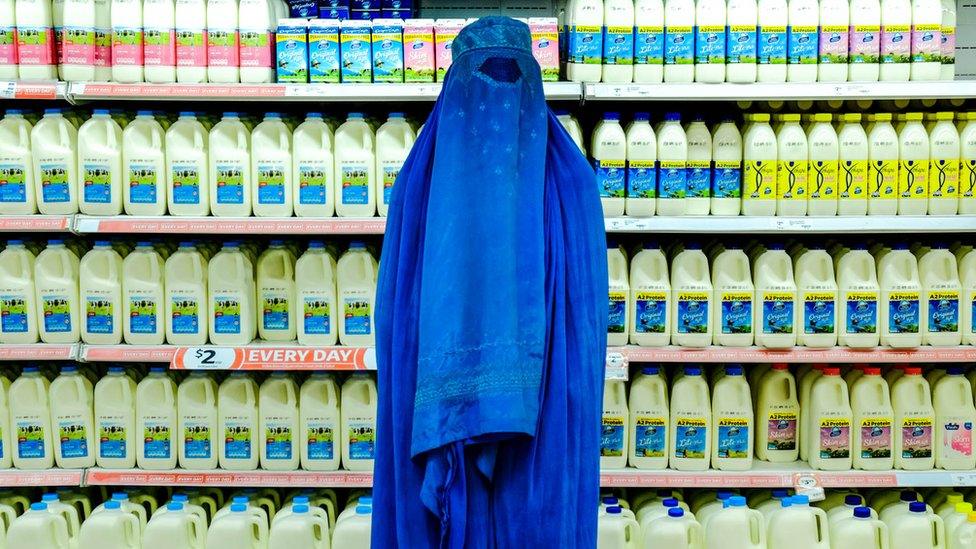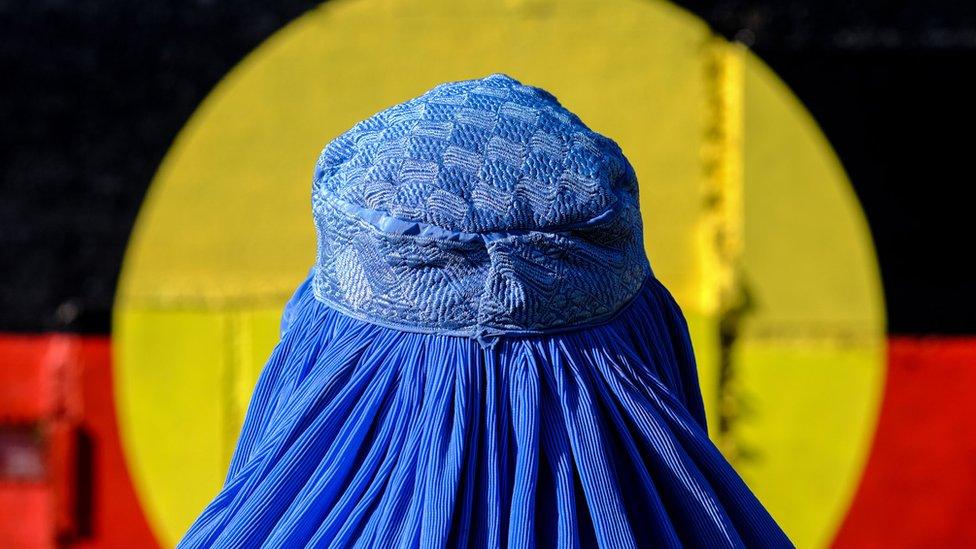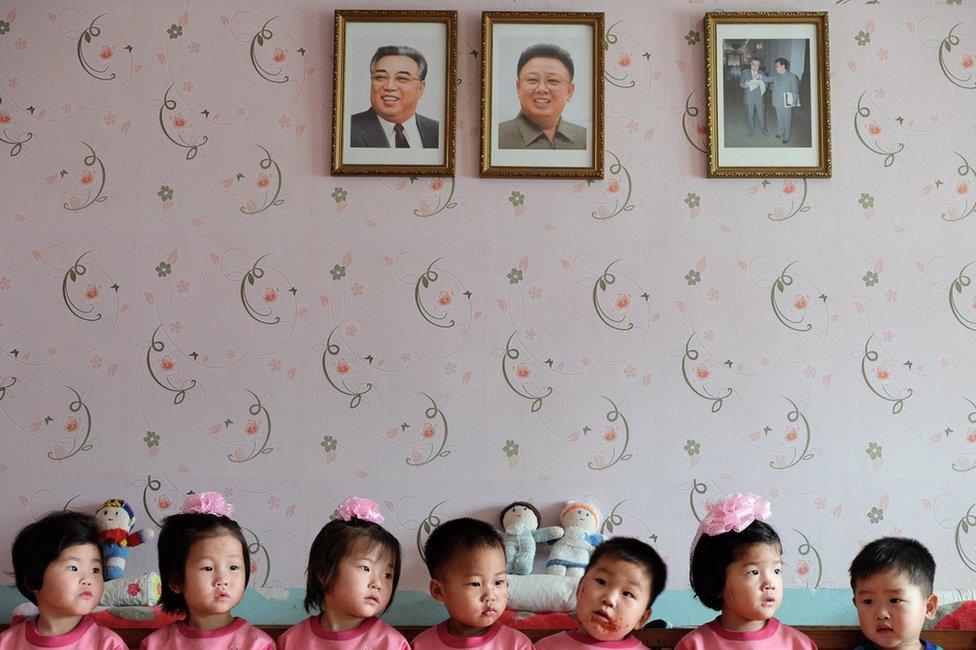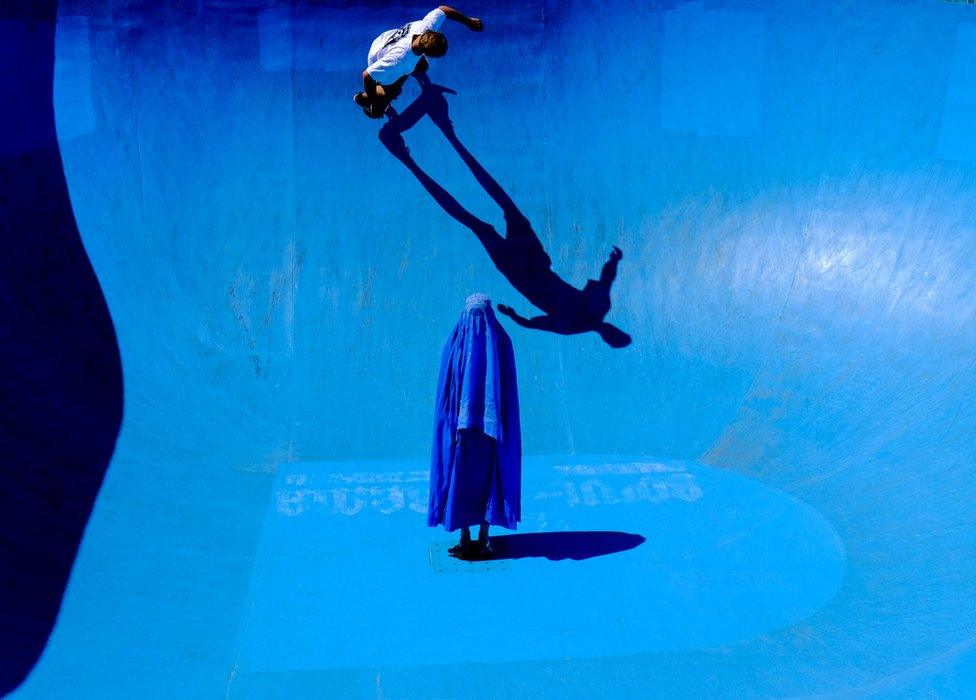Urban Burqa: An artist's striking critique of Islamophobia
- Published

Fabian Muir says his series critiques rising Islamophobia
When Tony Abbott, as Australian prime minister in 2014, appeared to support a ban on the burka being worn in Parliament House, award-winning photographer Fabian Muir had one response. He trekked 1,600km (1,000 miles) across his homeland, camera in hand.
Muir's resulting series pitted a cobalt-coloured garment of Afghanistan, alternatively spelled burqa, against Australia's most forbidding, and beautiful, terrains.
Blue Burqa in a Sunburnt Country features a lone figure standing against swirling skies on a ridge of yellow sand; reflected in clear water; and walking amongst a forest of dead trees.
Now Muir has made a follow up sequence - Urban Burqa.
Rather than pictured in the outback, a woman in blue stands, contrastingly, against the white of milk bottles in a supermarket. Other images include the figure outside a fluorescent McDonald's sign and in a concrete basement covered in graffiti.
The series is a critique of the rising far right and Islamophobia, Muir says.

Muir says his series deals with "confrontation and adaptation"
"Tragically, [anti-immigrant sentiment] has only become more magnified since 2014," says Muir, pointing out that 49% of Australians in a 2016 poll, external supported a ban on Muslims entering the country.
"The refugee crisis… is always such an easy target for politicians. There's always going to be a percentage of the population who swallows that because it seems like an easy solution to problems."
In Blue Burqa in a Sunburnt Country, Muir wanted to show how the burka complemented - and even enhanced - the landscapes: "It hinted or suggested a potential symbiosis of this country and immigrants, that runs counter to the narrative making the headlines at that time."
Urban Burqa, by contrast, touches more on a cultural clash. "It's still about simulation but there's also a sense of confrontation and adaptation, hence this darker, edgier feel to it," he says.
Born in a household of Australian creatives - Muir's mother was a director at Opera Australia, his father a director at the Australian Broadcasting Corp - Muir turned to photography after completing a law degree at Sydney University. He has since lived in Estonia, Lithuania, France, Spain and Germany.
Muir, who is in his 40s, credits his success to a lack of formal training.

The subject is photographed against the Aboriginal flag
"I personally think it's unnecessary and potentially dangerous for an aspiring photographer [to attend photography school]," he says. "Especially if they're young. They're going to potentially lack the fortitude to resist their teacher's vision."
Muir taught himself, learning on film. "The trial and error was quite expensive," he laughs. "Each shot cost me a dollar!"
Still, he appreciates the ability to pursue his own ideas "untrammelled and unburdened by someone else's vision".
Last year Muir completed his series Intimate Perspectives on North Korea, selected as a finalist in the Magnum Photography Awards.
"It's a time capsule," says Muir of the nation, which he visited five times over the course of two years.
Shepherded around by guides, he was only allowed to walk unaided - and unwatched - on a handful of occasions.

One of Muir's photos from North Korea
The photographer was first inspired to travel to North Korea after coming across Tomas van Houtryve's 2009 photo essay The Land of No Smiles.
He says Houtryve's images are powerful but bleak. "His descriptions are very acid, of children fleeing at the sight of him," he says. "What I saw was very different."
"The bleakness is part of the narrative," continues Muir. "But it's not the sole element. Almost more interesting was my experience of street level North Korea. They're really very warm and have a sense of humour, and enjoy very normal things."
In order to document this, Muir took photographs of picnics in the park, kids in a playground, and bathers at a beach resort. One of his most hard-hitting images is of young children in an orphanage sitting beneath portraits of Kim Il-sung and Kim Jong-il.
It works because of "the structural composition, which says something about North Korean society - this strict structure of children lined up under the presence of the leadership there," he says.
"For me it also raises questions: these infants, where are they going to be in the future? It asks questions about the future, it illustrates the present, and it also says something about the past."

Muir says his series ends on a hopeful note
Key was showing that there was more to the story than "unthinking robotic people and their hatred for America and Japan".
This hit home in 2015. "Out of nowhere I sensed this figure cannon balling towards me and arms were thrown around me. It was this guide I had on previous visits - he was in his sixties, quite eccentric and has fantastic sense of humour," Muir says.
"He was almost in tears to see me again. It was absolutely genuine - no one put him up to that."
With regards to Urban Burqa, Muir believes it ends on a hopeful note.
The last image shows a woman in a burka standing in a bright blue skate park. The shadow from a skater in a T-shirt and shorts skirts the crown of her covered head, his hand almost touching her.
"For me it's a nice closing image, it's optimistic - because of the reaching out," he says. "[But] there's a sense that there are a lot of barriers that have to be overcome."
Photos by Fabian Muir